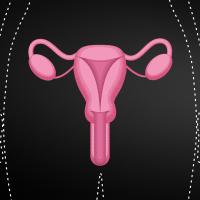Parkinson’s, Tourette’s, dystonia. What these movement disorders all have in common is that they can significantly reduce a person’s quality of life.
Movement disorders make it extremely difficult, and sometimes impossible, to perform everyday activities such as tying your shoes, drinking water, walking, and even talking. But there is hope.
Deep brain stimulation procedures address involuntary movement disorders at their source — inside the human brain. Although it might sound like the work of mad scientists, it’s become common practice for Dr. Michael Okun and Dr. Kelly Foote.
This neurologist and neurosurgeon team founded the University of Florida Center for Movement Disorders. They’re leading experts in the field of Deep Brain Stimulation, where small electrodes are implanted in the brain to stimulate affected regions. With DBS, it’s possible to stop the abnormal activity within the brain that causes the symptoms of movement disorders.
Altering the Brain’s Circuitry
Before deep brain stimulation, movement disorders were primarily treated with medications intended to help alleviate symptoms such as tics, slurred speech, and limited mobility. Medications, however, do not provide adequate relief for many patients. If a patient is unable to control symptoms with medication alone, they could be a candidate for deep brain stimulation.
What is deep brain stimulation? The brain is said to contain about 100 billion neurons which are linked together. These links are called “synapses.” Neurons communicate and send commands to the body by firing electrical signals along these pathways inside the brain.
Although doctors are still learning more about deep brain stimulation, it’s believed to repair, restore, or restructure synapses in patients with neurological conditions, as electricity stimulates specific groups of neurons.
Inside the Operating Room During Deep Brain Stimulation
During deep brain stimulation surgery, it’s essential that the surgical team is able to communicate clearly with the patient. Although patients are fully numbed to ensure they feel no pain, they aren’t given sedatives, so they remain awake and alert throughout the surgical procedure.
During deep brain stimulation, a neurosurgeon inserts fine wires into the patient’s brain, targeting highly precise locations which are responsible for controlling specific functions. As Dr. Okun explains, “Millimeters matter. If you miss by a millimeter or two, it can be (like) the distance between the University of Florida and California.”
In other words, doctors could wind up stimulating the wrong neurons, triggering an unintended response. But during the procedures, the medical team works with the patient. They ask questions and request that the patient performs various tasks, like drawing a spiral or lifting their arm.
These assessments help the medical team locate the correct neurons to stimulate, and determine an effective level of therapeutic stimulation.
Potential Drawbacks and Deep Brain Stimulation Side Effects
Deep brain stimulation surgery is a minimally invasive procedure that’s considered quite safe, but no surgical procedure is completely free of potential risks, complications, or side effects. As a result, it’s reserved for patients with severe cases who no longer exhibit a sufficient response to medications.
The DBS procedure involves cutting small holes into the patient’s skull and a surgery for implanting a battery pack beneath the skin in the patient’s chest. Patients also require future procedures to replace the battery once it has worn out, usually every two to five years.
The potential complications of these procedures are serious and include infection, bleeding in the brain, seizures, and stroke. After a successful surgery, doctors activate the implanted device to begin the process of deep brain stimulation.
While doctors work to find the perfect settings, patients may experience side effects like tingling sensations, numbness, muscle tension, dizziness, and vision disturbances.
Many potential patients also take DBS’s hefty price tag into consideration. How much does deep brain stimulation cost? Each surgery can cost up to $50,000. However, some patients’ insurance plans cover the costs of deep brain stimulation for Parkinson’s.
In spite of the expense and long list of potential risks, many people are lining up for deep brain stimulation. To them, deep brain stimulation can mean the difference between walking or needing a wheelchair, feeding themselves or needing to be fed, being able to work or having to give up a career.
For younger patients, DBS can provide the opportunity to develop healthily and experience childhood more fully.
Quality Care From a Team of Medical Professionals
Doctors Michael Okun and Kelly Foote like to joke that they’re an unlikely pair because, in the medical world, surgeons and non-surgeons don’t usually mix. However unusual their partnership, the co-founders of the University of Florida Center for Movement Disorders make an excellent team.
According to Drs. Okun and Foote, a patient receives the best care when a team of medical practitioners from different disciplines gets together to talk behind the patient’s back. At the Center for Movement Disorders, Okun and Foote have designed a model that allows patients to come to one place and see every type of doctor they need.
This model is not only more convenient for patients, but it also enables a uniquely powerful collaboration of minds. A team comprised of a neurologist, neurosurgeon, psychiatrist, neuropsychologist, physical therapist, occupational therapist, speech and swallowing expert, and social worker meet with the patient and then come together to discuss the individual case.
This interdisciplinary model facilitates a thorough pre-surgery workup, adequately prepares the patient for the procedure, and leads to a more accurate understanding of the patient’s brain.
Ultimately, Drs. Foote and Okun strive to achieve a treatment model that leads to the best possible patient outcomes.
The Future of Deep Brain Stimulation
So far, deep brain stimulation is an approved treatment for Parkinson’s, epilepsy, essential tremor, dystonia, and obsessive-compulsive disorder (OCD). DBS surgery is also being studied as a potential treatment for other conditions including Tourette’s Syndrome, chronic pain, dementia, multiple sclerosis, and stroke recovery.
As Drs. Okun and Foote put it – the brain controls everything, and deep brain stimulation has the power to control your brain. Although the thought of implanting an electrical device into the brain can make people feel uneasy, this exciting treatment model has the potential to help relieve human suffering.
If helping people regain control of their bodies, emotions, and lives can alleviate that suffering, then deep brain stimulation is not something to fear, but something to celebrate.
For more interesting news about the people and ideas that are changing our world, subscribe to Freethink.
Update: This video incorrectly states that Dr. Michael Okun is a neurosurgeon. He is a neurologist. We regret the error.


